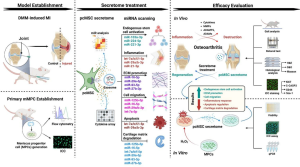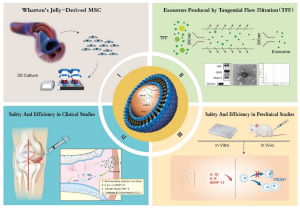SSRN, 20 May 2025
Mesenchymal stromal cells derived from Wharton’s jelly (WJ-MSCs) are multipotent cells originating from the umbilical cord, possessing strong immunomodulatory properties. These characteristics make them promising candidates for therapies targeting immune-related diseases.
Background of the Study
Graft-versus-host disease (GVHD) occurs when donor-derived immune cells attack the recipient’s body after transplantation. Although mesenchymal stromal cells (MSCs) have been known for their immunosuppressive abilities, their clinical efficacy in treating GVHD remains limited and inconsistent.
Methods
- GMP-Grade WJ-MSC Preparation
- Source: Human umbilical cords were collected post-delivery at the University Maternity Hospital of Nancy, with written informed consent from the mothers, following French legal and ethical guidelines (DC-214-2114).
- Isolation Protocol:
- Umbilical cords were sliced into 3 mm sections and adhered to the bottom of TPP culture flasks. After 15 minutes of adhesion, α-MEM medium supplemented with 5% human platelet lysate was added, and the cells were cultured under hypoxic conditions (5% CO₂, 5% O₂) at 37 °C.
- After 10 days, the tissue explants were removed. When cultures reached 80% confluency, the cells were harvested, trypsinized, and reseeded at a density of 3,000 cells/cm².
- Upon expansion, the cells were cryopreserved at 1×10⁶ cells/mL in a solution containing 10% human albumin and 10% DMSO.
- Post-thaw Recovery: Cells were thawed in a 37 °C water bath for 5 minutes, washed in fresh medium, and cultured for 7 days under hypoxic conditions.
- Pre-treatment with IFN-γ: WJ-MSCs were activated with 100 ng/mL interferon gamma (IFN-γ) for 48 hours prior to in vitro and in vivo assays.
- In Vitro Evaluation
- Human T cells were co-cultured with WJ-MSCs to assess suppression of proliferation, induction of cell death, and exhaustion. Immune regulatory molecules such as PD-1, IDO, and Galectin-9 were analyzed via flow cytometry and ELISA.
- In Vivo Experiment: Xenogeneic GVHD Mouse Model
- Model: 8-week-old female NSG mice (Jackson Laboratory) were irradiated with 200 cGy total body irradiation.
- GVHD Induction: Mice were injected with 5 × 10⁶ human peripheral blood mononuclear cells (PBMCs).
- Treatment Groups:
- Control group: PBMCs + PBS only.
- Treatment groups: 5 × 10⁵ WJ-MSCs (with or without IFN-γ pre-treatment), injected on day 0 or on a weekly basis (days 7, 14, 21).
- Monitoring:
- Survival rate and body weight were assessed every 2 days.
- GVHD severity was evaluated by analyzing human CD45+ cells in blood, and by histological scoring (HE staining) of liver, skin, gut, and spleen.
- Statistical Analysis: Data were analyzed using GraphPad Prism software. Statistical tests included t-test, ANOVA, Kaplan-Meier survival curves, and log-rank test.
Key Findings
GMP-grade WJ-MSCs demonstrated significant in vitro T cell proliferation suppression, which was markedly enhanced by IFN-γ pre-treatment. This effect was primarily mediated by the enzyme Indoleamine 2,3-dioxygenase (IDO).
In the mouse model, three weekly injections of IFN-γ-treated WJ-MSCs significantly improved survival and reduced GVHD-related tissue damage, particularly in the liver and skin.
Conclusion and Future Perspective
This study concludes that GMP-compliant WJ-MSCs pre-treated with IFN-γ effectively prevent GVHD in a preclinical model. These results support their inclusion in optimized dosing regimens for future clinical trials. Enhanced immunosuppressive efficacy also suggests potential for treating severe or refractory GVHD cases.
References
The article was translated and summarized from the research paper: Optimized GMP-grade Wharton’s jelly’s mesenchymal stromal cells manufacturing and administration protocol for Graft versus Host disease prevention. SSRN. https://doi.org/10.2139/ssrn.5256203
Source: SSRN
Link: https://papers.ssrn.com/sol3/papers.cfm?abstract_id=5256203








